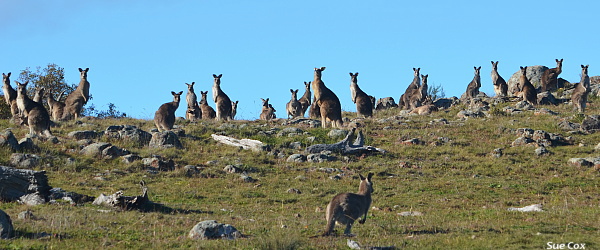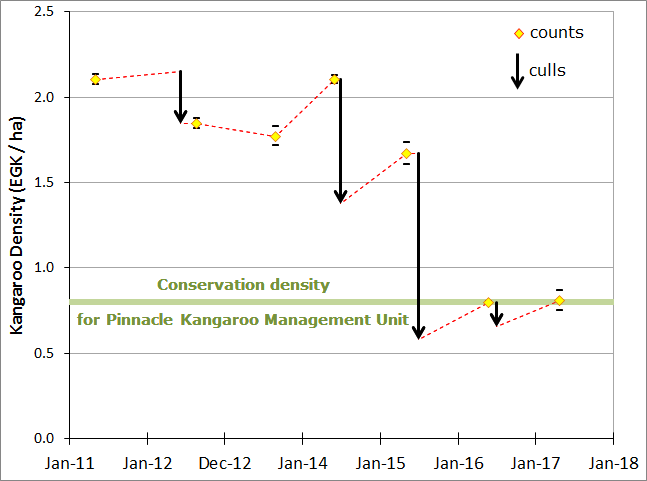  |
managing kangaroos on the pinnacle |
|
Kangaroos at The Pinnacle Nature Reserve Whether encountered in a large mob or in small family groups, it is always a delight and it is one of the pleasures of walking in the Reserve. It also makes it a great place to bring visitors from overseas, or from other parts of Australia where kangaroos are not so common.
This is, of course, a result of culling carried out under the ACT Government Kangaroo Management Plan, which aims to maintain a sustainable population of kangaroos and which is supported by Friends of The Pinnacle. While it is wonderful to have kangaroos prevalent on the Reserve, it is possible to have too much of a good thing; an overpopulation of kangaroos may have a deleterious impact on the rest of the ecosystem, as described in the research summary below. Evidence of the impact of the large number of kangaroos on the Reserve was particularly noticeable during the drought years at the turn of this century, at which time fotpin's concern initially arose, but their impact was still been apparent in the years since the drought ended in 2010. Perhaps the most obvious effect, for a casual observer who gets off the walking tracks, was the creation of large bare areas where they camp, usually under trees. Many examples can be found where a kangaroo-produced bare patch has led to erosion of the topsoil and, in many cases, the even more fragile underlying subsoil. [For more details, see Kangaroo Camps on The Pinnacle.] The large population of kangaroos prior to 2015 also had a marked effect on grass cover. Data from fotpin’s grass experiment shows that when they were excluded from areas there was considerably more grass covering the soil surface; unfenced areas showed heavy grazing of native grasses and the the prevention of seed-set. This grazing impact has been shown (see the research summary below) to affect not only the biodiversity of grass and other plant species but also on the fauna that inhabit or feed on that ground-layer vegetation. The Pinnacle kangaroo population is confined by the suburbs to the north and major roads to the west, south and east, which they cross at their peril. In good seasons, the absence of predators, combined with their being confined, results in the population being unconstrained except by food supply. Overgrazing (and eventually starvation) is therefore the natural consequence, unless the population is constrained to human intervention. Kangaroos in the ACT The grasslands and grassy understorey of woodlands that are part of the Canberra Nature Park provide ideal habitat for Eastern Grey Kangaroos. In many areas kangaroos make use of remnant woodland areas for daytime shelter and protection from predation. Prior to the expansion of urban and other development, these grassland areas were in rural lease and mainly used for grazing. Kangaroo numbers were maintained at a relatively low level by competition for food with sheep and cattle and by their main predators, namely dingoes and wild dogs and the culling undertaken on rural leases. In reserved areas, competition and predators are now missing. Except for mortality from vehicle collisions, the main limitation on kangaroo population growth is food supply. Across the lowland grasslands, kangaroo populations are still increasing. Eastern Grey Kangaroos perform an important role in native grasslands; however, their density in grassland remnants is a significant management issue. Sustained heavy grazing pressure can lead to deleterious impacts on grassland communities and the animals and plants that depend on these grasslands for habitat. This impact is similar to that of overgrazing by livestock. Overgrazing is of particular concern when it affects endangered grassy ecosystems and threatened animals and plants, as any reduction in the suitability or quality of their habitat places them at higher risk of extinction. Overgrazing may also affect the regeneration of woodland tree species. Research on Kangaroo impacts in the ACT The Conservation Research, Environment and Planning Directorate (CREP) of the ACT Government has been carrying out a range of research projects to measure the impact of kangaroo grazing on biodiversity (see Summary of recent papers, April 2015 [ Evidence for the effect of kangaroos on vegetation in a nature reserve has also been documented in research by the Friends of Mt. Majura. Kangaroo Counts at The Pinnacle Nature Reserve Conscious of the management issues associated with kangaroo numbers, as outlined above, the fotpin Coordinating Committee requested that the Reserve be included as part of the series of kangaroo counts that were carried out around various parts of the Canberra Nature Park in autumn 2011. The count area (kangaroo management unit, KMU) is 367 hectares in size and includes the Reserve along with the adjacent properties (North Kama, Bottom Pinnacle and the rural lease - see location map) bounded by William Hovell and Coulter Drives. This area, bounded by highways and the suburbs, is the natural range of the kangaroos, which are not deterred by the fences between paddocks, but do hesitate to stray into the suburbs or onto the highways. The count has now been carried out in six successive years, on 1 May 2011, 19 August 2012, 25 August 2013, 1 June 2014, 3 May 2015, 22 May 2016 and 23 April 2017. Unlike counts carried out in other areas around the ACT, these were carried out predominantly by volunteers organised by fotpin. The experts were on hand to drill us in the procedure and guide us through the process of a "sweep count", and we're grateful to Don Fletcher and colleagues from the Conservation Research Section for giving up a Sunday each year to join us. The sweep count is carried out in the same way each year and the methodology is contained in the description of the 2011 count. From 2017 fotpin decreased it's involvement in organising the count and responsibility for the count shifted to the Conservation Planning and Research unit. The count in 2018 produced questionable results because there were insufficient people to carry out an effective sweep resulting in large numbers of kangaroos passing through the line without being counted accurately. In 2019 the count had to be abandoned because the safety fences associated with the Molonglo Watermain construction divided the KMU with only one smallbreak through which kangaroos could pass, making an effective sweep impossible. The results of the counts have been used by CREP staff to help make informed kangaroo management decisions. The fotpin Coordinating Committee supports this approach - such as conducting kangaroo culls - where this is needed to protect the overall ecological health of the Reserve. Results from the five years of counting are presented below.
In 2016, the population density calculated from the latest count (0.8 EGKs/ha) was consistent with the estimated "conservation density" (see Note) for the Pinnacle KMU, which has been estimated by CREP to be 0.79 EGK/ha. Without culling, based on the fertility rate estimated from the previous year, the population would have likely have increased considerably over this period and the density would have been well in excess of 2 EGK/ha. This was the first time since we commenced annual counts that the two have been consistent, and was repeated in 2017. It is important to note that once the "conservation density" was reached, only a small cull was required to maintain it.
This figure tracks (dashed red line) the history of kangaroo density in the Pinnacle KMU by combining the
mean
count numbers (shown as yellow diamonds*) and the cull numbers. After the last cull the estimated density was 0.58, and that has rebounded to 0.8 at the last count, indicating a 37% per annum population growth rate. Fotpin is optimistic that our annual counts coupled with the careful planning of culls by CREP staff will assist to maintain the density at a value around the conservation density into the future, with benefits for both the kangaroo population and the other native flora and fauna populations on the Reserve.
Note:
Further Reading from fotpin A Sunday walk with a difference photo gallery - 5 years of roo counting 2012 kangaroo cull - fotpin position statement kangaroo camps on the Pinnacle Nature Reserve from ACT Government Management of Kangaroos in the ACT ACT Kangaroo Management Plan, 2010 [ Eastern Grey Kangaroo Management Plan, 2017 [ Calculation of the number of kangaroos to cull [ Summary of recent papers, April 2015 [ 2015 Kangaroo Conservation Control Program - Questions and Answers [ from other ParkCare groups Friends of Mt. Majura research on kangaroo impacts
|
|||||||||||||||||||||||||||||||||||||||||||||||||||
© Friends of The Pinnacle
 People who have visited The Pinnacle regularly for many years will have noticed a change over the last couple of years. It is now fairly uncommon to see the large numbers of kangaroos that were often encountered in the past.
People who have visited The Pinnacle regularly for many years will have noticed a change over the last couple of years. It is now fairly uncommon to see the large numbers of kangaroos that were often encountered in the past. 
